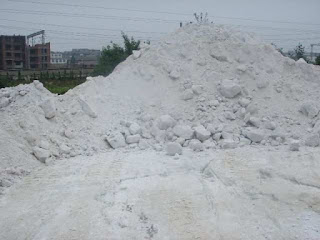Mineral processing unit operation and examples
UNIT OPERATIONS
In mineralprocessing plant, Numerous
steps, called unit operations, are involved in achieving the goal of extracting
minerals and metals from ores in their purest possible form. These steps include
Size reduction. The process of crushing and grinding ores is known as
comminution. The purpose
of the
comminution process is threefold: (1) to liberate valuable minerals from the
ore
matrix,
(2) to increase surface area for high reactivity, and (3) to facilitate the
transport of ore
particles
between unit operations.
Size separation. Crushed and ground products generally require
classification by particle size. Sizing can be accomplished by using
classifiers, screens, or water elutriators. Screens are used for coarse
particulate sizing; cyclones are used with fine particulates.
Concentration. Physicochemical properties of minerals and other solids
are used in concentration operations. Froth flotation, gravity concentration,
and magnetic and electrostatic concentration are used extensively in the
industry.
— Froth flotation. The surface properties of minerals
(composition and electrical charge) are used in combination with collectors,
which are heterogeneous compounds containing a polar component and a nonpolar
component for selective separations of minerals. The nonpolar hydrocarbon chain
provides hydrophobicity to the mineral after adsorption of the polar portion of
the collector on the surface.
— Gravity concentration. Differences in the density of minerals
are used to effect separations of one mineral from another. Equipment available
includes jigs, shaking tables, and spirals. Heavy medium is also used to
facilitate separation of heavy minerals from light minerals.
— Magnetic and electrostatic
concentration. Differences
in magnetic susceptibility and electrical conductivity of minerals are utilized
in processing operations when applicable.
Dewatering. Most mineral processing operations are conducted in the
presence of water. Solids must be separated from water for metal production.
This is accomplished with thickeners and filters.
Aqueous dissolution. Many metals are recovered from ores by dissolving the
desired metal(s)—in a process termed leaching—with various lixiviants in the presence of oxygen. Following leaching, the
dissolved metals can be concentrated by carbon adsorption, ion exchange, or
solvent extraction. Purified and concentrated metals may be recovered from
solution with a number of reduction techniques, including cementation and
electrowinning.
EXAMPLES OF MINERAL PROCESSING
OPERATIONS
Figure 1
shows a typical flowsheet for crushing and sizing rock in a quarrying
operation. Run-of-mine ore can be present as lumps as large as 1.5 m (5 ft) in
diameter. In this figure’s example, 91.4-cm (3-ft) lumps of rock are fed to a
crusher that reduces the material to 20.3 cm (8 in.) or less in diameter. After
screening to remove rock that is less than 57.2 mm (21/4 in.) in size, rock between the sizes of
57.2 mm (21/4 in.) and 20.3 cm (8 in.) is further reduced in size by a gyratory crusher.
The product from this step is then classified by screening to the desired
product for sale.
Figure 2
shows an integrated circuit demonstrating crushing, grinding, size separation,
and gravity concentration of a tin ore. Initial size separation is effected
with a grizzly set at 11/2-in. Oversize material is fed to a jaw crusher set at 11/2-in., and the
crushed product is, then, further reduced in size to 20 mesh by ball milling.
The –20-mesh material is classified by hydrocyclones set at 150 mesh, and the –150-mesh material is sent to shaking
tables to concentrate the heavy tin mineral, cassiterite. The middlings in this
process receive additional treatment. The concentrate from this operation is
reground and sized at 200 mesh. Two-stage vanning is used to produce a fine tin
concentrate.
The
flowsheet describing the flotation processing of a copper ore containing
chalcopyrite and molybdenite is shown in Figure 3. After grinding and
classification, pulp is fed to rougher flotation. The rougher tailings are
thickened and sent to a tailings dam. The rougher concentrate is classified, and
the oversize is reground. Cyclone overflow is fed to cleaner flotation, and the
cleaner concentrate is recleaned. Cleaner tailings are recycled back to rougher
flotation, and the recleaner concentrate is thickened and sent to the
molybdenum recovery plant for further processing. In this operation, the feed
contains 0.32% Cu and 0.03% Mo. Rougher concentrate, cleaner concentrate, and
recleaner concentrate contain 7%–9% Cu, 18% Cu, and 25% Cu, respectively. Recleaner
concentrate also contains 2%–3% Mo.
Figure 4
depicts a flowsheet for processing free-milling oxidized gold ore. The kinetics
of gold leaching is slow, and gold ores are frequently ground to less than
about 75 μm before leaching. Even then, one day is usually required in the
leaching step. In this process, run-of-mine ore is crushed and ground. The ball mill discharge in subjected to gravity concentration to recover the larger
particles of free gold. The tailings from this operation are thickened, and the
underflow from the thickeners is then subjected to cyanide leaching. In some
instances, ores may contain oxygen-consuming minerals, such as pyrrhotite and
marcasite, and a preaeration step may be conducted ahead of cyanide leaching.
Heap
leaching has revolutionized the gold mining industry. Low-grade oxidized ores
containing approximately 0.03 oz gold per short ton of ore can be processed
with this technology, whereas they could not be processed by the higher cost
grinding/agitation leaching (milling) process. Figure 5 presents a simplified
flowsheet of heap leaching. As the figure shows, run-of-mine ore may or may not
be crushed. If crushing is done, the ore is generally crushed to <2 in. in
diameter.
sinonine can also provide sand washing plant epc.
Sinonine technology team






评论
发表评论